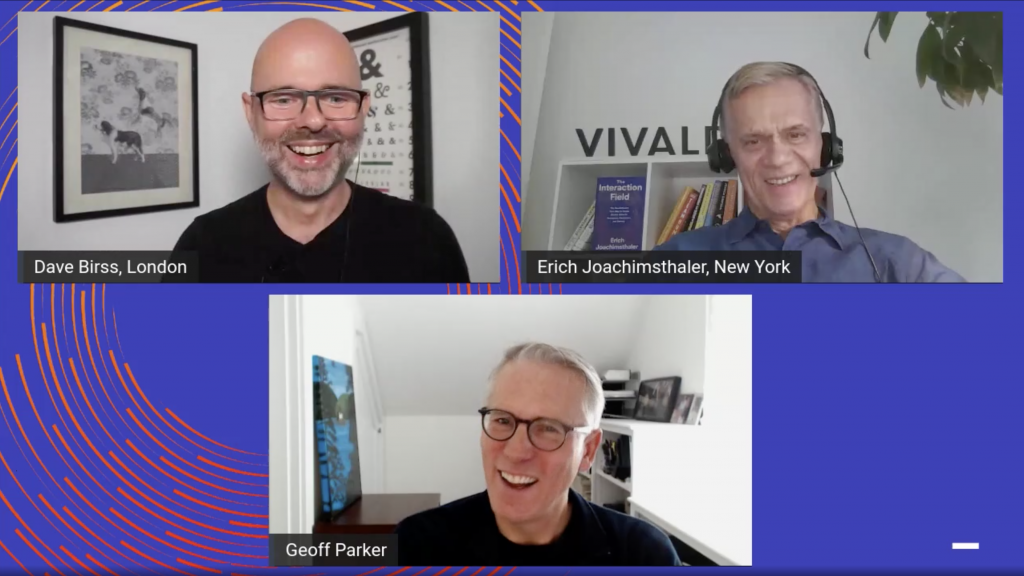The Inverted Firm with Geoff Parker: Platform Is The New Norm

As consumerism migrates en masse online during the pandemic, businesses turn to digital transformation as an imminent need. In this conversation, Platform Strategy Scholar and MIT Professor, Geoffrey Parker, and our Founder and CEO, Erich Joachimsthaler, discussed the idea of the inverted firm and how Platform Strategies can save companies. Geoff gave us insights into looking at scaling your business with a different lens, how traditional metrics of evaluating business growth and strategy may not apply in the platform economy, and how businesses can learn to operate in this Post-COVID world.
Here are some of the key principles from Geoff Parker:
1. Organizations that adopt the platform model are those types of companies scale a lot faster. Traditional firms with relatively stable supply-chain do not pivot as quickly as a platform company could. When they have their supply or demand side disrupted, it is more difficult to navigate where to start addressing the problems. Platforms enable working with a broader set of ecosystem partners on both the supply and demand side. The digital platform provides a better overview of solution pathways.
“The important idea is that a lot of the value add starts to take place outside the four walls of the platform sponsor firm, and it’s really being executed by an ecosystem partner in a much more kind of decentralized way.” – Geoff Parker
2. There are numerous reasons for the high failure rate of digital transformation and platformization of companies. The metrics typically used to evaluate digital transformation initiatives in non-platform businesses are derived from standard linear models and practices that historically do not have a high success rate. Before these initiatives reach the scale or growth they need to succeed, the traditional metrics and initiatives shut down. It is difficult for these initiatives to succeed within big companies because “anti-bodies” exist that stamp out digital transformation initiatives. Communicating the importance of this transformation to the organization helps align initiatives.
“It’s a big management challenge for leadership to explain organization-wide why this makes sense-why cannibalizing our a revenue stream is within everyone’s best interest.” – Geoff Parker
3. The inverted firm is achieved by shifting the production from inside the company to its ecosystem partners. Network effects cannot occur internally and within standalone companies, but it becomes easier if companies look within their business frame in the ecosystem. If companies start organizing towards shared value, then the deep-rooted system could be addressed while benefiting multiple players. An open system allows for more opportunities and orchestration to innovate and solve problems.
“In order to do the inverted firm model, there are a lot of assumptions. And a lot of that is going to be this end-to-end digital kind of visibility. That assumes a common data model that assumes we have sort of worked horizontally across the enterprise, and then we’re able to plug in at different points. A lot of times it just doesn’t work that way.” – Geoff Parker
There is a lot to gain from Platform Strategies:
- Platforms allow for accelerated response: Platforms can detect new consumer patterns and immediately sync to automate, inform, and dictate the supply and demand shifts. The responsiveness of platforms allows businesses to innovate and adapt quickly and with ease.
- Investing in digitalization is investing in visibility: Complete visibility from end to end allows the firms to connect with different players through intersection points in varying application services and interfaces. Network effects take place accordingly. As the number of users increases, the value of the overall system to the individual users also increases.
- Understand the benefits of inverted firms: Companies must look across all operations to find opportunities for other players to build from and to layer digital value. The ecosystem partners consequently scale, execute, and develop the added value that provides facile advantages to your company
Conclusion
Companies that leverage platform thinking and ecosystem partners are more resilient and adaptable in this economy because they are used in scalable business models. It is not that the Porter’s 5 forces model is incorrect, it is just incomplete. Strategy today is not just about finding out where to play and how to win. Making an impact with agility and leveraging the shared interests of your ecosystem bolsters dominating the field.
Watch the full event here:
- 7:58 – Communicating Digital Transformation to your company
- 10:10 – Willingness of manufacturing companies to rapidly experiment and change their business models
- 12:22 – The Inverted Firm
- 15:06 – Food truck platform example
- 17:19 – Traditional vs Platform Strategy
- 18:39 – Network effects
- 25:35 – Digital visibility
- 27:41 – Enabling infrastructure
- 33:55 – Copycats in network effects
- 38:36 – Advantages of omni-channels
- 42:16 – First step for inverted firms
This segment was part of The Interaction Field Series of our LinkedIn Live Events. Please connect with us on our LinkedIn page to stay updated with our upcoming conversations.
